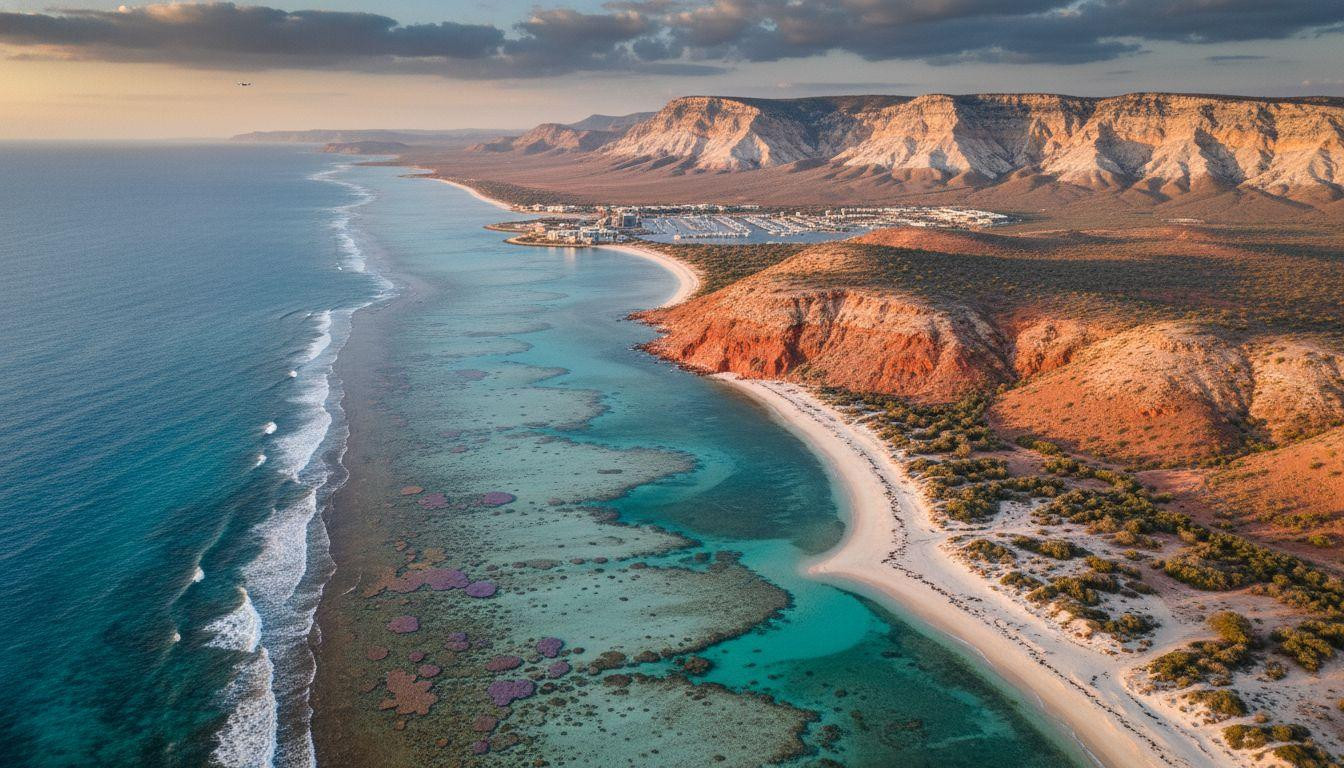At 6:47 AM, spotter planes circle above Ningaloo Reef as the first whale shark tours prepare to launch from Exmouth Marina. This remote Western Australian town, 745 miles north of Perth, guards access to the world’s largest fringing reef and the planet’s most reliable whale shark encounters. While Great Barrier Reef struggles with mass tourism and coral bleaching, Ningaloo thrives as a UNESCO World Heritage wilderness where ancient marine rhythms still dictate the seasonal calendar.
Seven extraordinary encounters await along this 186-mile coastline. Each offers what Queensland’s commercialized reefs have lost: pristine coral gardens, intimate wildlife interactions, and the freedom to swim with giants without fighting crowds.
Whale shark adventures that redefine gentle giant encounters
Ningaloo holds the global record for whale shark accessibility. In 2025, operators report a staggering 95% sighting success rate during peak season (April-July). Compare this to Great Barrier Reef destinations where whale shark encounters remain hit-or-miss propositions requiring expensive liveaboard expeditions.
Full-day tours from Exmouth cost $575 AUD ($374 USD) per adult, with maximum group sizes of 20 swimmers. Cape Leveque’s red cliff coastline offers similar Indian Ocean wilderness, but lacks Ningaloo’s predictable whale shark congregations. Spotter planes locate feeding whale sharks before boats arrive, ensuring efficient encounters with 40-foot filter-feeders gliding through plankton clouds.
Tour operators include all snorkel equipment, wetsuits, gourmet meals, and professional underwater photography. If no whale sharks appear, companies provide free repeat tours or vouchers valid for three years.
The legendary “Big 3” challenge that exists nowhere else
For six weeks annually (late August through September), Ningaloo becomes Earth’s only location where whale sharks, humpback whales, and manta rays reliably overlap. This phenomenon creates the planet’s ultimate marine wildlife challenge: encountering all three megafauna species in a single day.
August through September magic
Premium “Big 3” tours cost $550 AUD ($358 USD) with 82% success rates during peak overlap periods. Extended 10-hour expeditions use larger vessels equipped for rapid repositioning between whale shark feeding areas, manta ray cleaning stations, and humpback whale migration corridors. Radio networks coordinate between tour boats and aerial spotters to maximize encounter opportunities.
What makes it unique
Great Barrier Reef lacks consistent whale shark presence during humpback season, making similar multi-species encounters impossible. Ningaloo’s manta rays average 13-foot wingspans compared to Great Barrier Reef’s smaller 11-foot specimens. The resident manta population exceeds 200 individuals, with 98% sighting reliability at established cleaning stations.
Coral spawning spectacles that trigger the entire ecosystem
Seven to ten days after each March or April full moon, Ningaloo’s coral colonies simultaneously release millions of eggs and sperm in underwater snowstorms. This mass spawning event creates the plankton blooms that attract whale sharks, forming the foundation of the reef’s seasonal marine congregation.
Witnessing nature’s fertility ritual
Night diving tours position snorkelers above coral gardens as the spawning begins. Pink, orange, and white gamete bundles rise toward the surface in slow-motion clouds while bioluminescent plankton create an underwater aurora. Tasmania’s Tarkine Coast offers comparable UNESCO wilderness, but lacks these synchronized coral reproduction displays.
Planning for 2026
Based on lunar calendars, 2026 coral spawning will likely occur March 25-April 2 (following the March 15 full moon). Water temperatures must reach 79-81°F to trigger spawning. Night tours run $180 AUD ($117 USD) during the narrow viewing window.
Year-round reef access that costs almost nothing
Unlike Great Barrier Reef’s mandatory boat tours, Ningaloo’s fringing structure allows world-class snorkeling 164 feet from shore. Turquoise Bay offers Australia’s most famous drift snorkel: enter at one beach, float 656 feet through coral channels, exit downstream. No boat required.
Daily park entry costs just $25 AUD ($16 USD) with unlimited access to pristine coral gardens hosting 200+ fish species. Coral health monitoring shows 95% live coral cover compared to Great Barrier Reef’s 38% average following recent bleaching events. Madagascar’s Île Sainte-Marie provides similar budget-friendly whale encounters, but lacks Ningaloo’s accessible reef systems.
Visibility regularly exceeds 98 feet with water temperatures maintaining 75-82°F year-round. Early morning snorkeling (7:00-9:00 AM) offers optimal conditions before afternoon winds develop.
Your Questions About Exmouth whale shark experiences Answered
When is the best time to visit for multiple species encounters?
Late August through September offers the legendary “Big 3” overlap when whale sharks, manta rays, and humpback whales share the same waters. April-July provides peak whale shark density with 95% sighting guarantees. March offers coral spawning spectacles plus early whale shark arrivals.
How does Ningaloo compare to Great Barrier Reef tourism?
Ningaloo welcomes 150,000 annual visitors versus Great Barrier Reef’s 2 million+, resulting in 13 times fewer people per square mile. Coral bleaching affected only 5% of Ningaloo in 2024 compared to 80% of northern Great Barrier Reef sections. Cape York Peninsula offers similar remote 4WD adventures with pristine coastal access.
What’s the total cost for a three-day Exmouth experience?
Budget breakdown: whale shark tour ($374 USD), accommodation three nights ($180-270 USD), car rental ($120 USD), meals ($90-150 USD), park fees ($16 USD) totals $780-930 USD. Comparable Great Barrier Reef experiences cost $1,200-1,800 USD with inferior whale shark access and larger tour groups.
Dawn breaks over Indian Ocean waters as 40-foot whale sharks glide through plankton clouds beneath circling spotter planes. This is Ningaloo Reef, where marine encounters still feel like discovery rather than destination tourism.
